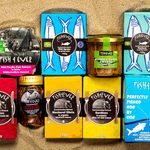You have no items in your shopping cart.
“Eating oil-rich fish remains the best way to obtain these oils for the general population. This is because ‘real’ food provides a greater array of nutrients than a pill, and some experts believe these are more easily absorbed than the ones in supplements. The BHF recommends eating two or three portions of oil-rich fish a week over taking a capsule.” Victoria Taylor, senior dietician, British Heart Foundation.
I’m sure we’re all used to seeing Omega 3 listed on products, as well as having the virtues of taking regular capsules bestowed upon us. But what exactly is it, why is it important, and what are the best sources?
Omega 3 is a polyunsaturated fat, described as the healthiest fat you can eat. There is strong evidence of significant health benefits derived from Omega 3, covering conditions such as heart disease, high blood pressure, irregular heartbeat, diabetes and increasing evidence of positive effects in many other areas of health - including depression. It is getting the right balance of Omega-3 and Omega-6 (both poly-unsaturated fats) that is the key to unlocking these potential benefits.

Medical experts recommend that the correct ratio of Omega 3:6 is around 1:3 to 1:5. Currently in the developed world the ratio is nearer 1:10 to 1:20. To correct this imbalance we need to increase our intake of Omega-3 fatty acids and decrease the intake of Omega-6 fatty acids. But Omega 3 by itself is not the full story, the source of the Omega 3 is also a factor.
Vegetable sources of Omega 3 are a good source of alpha-linolenic acid (ALA) but this is what is known as a short chain fatty acid and it is the long chain fatty acids which are health critical. These are basically only found in the marine environment.
Long chain Omega-3’s consist of two key substances: docosahexaenoic acid (DHA), critical in the development of the human brain, for eye and vision maintenance and brain function in all age groups; and eicosapentaenoic acid (EPA), vital for heart and joint health. The human body can, in theory, convert the short chain ALA to DHA and EPA but not at all well. On average there is only a 5% conversion from ALA to EPA, and less than 0.5% from ALA to DHA, so in reality vegetable sources of Omega-3 are simply not a viable alternative to marine based sources when it comes to human health – although there is some “promising research” of algal oils. As for fish supplements there is a lot of variability in quality, many go rancid and very few brands contain DHA in the required levels.
As per the advice of the British Heart Foundation, quoted at the top of this piece, we recommend including oily fish in your diet 2 to 3 times per week. Mackerel, Sardines and Anchovies are all excellent sources of Omega 3, with tuna also rating as a good source.













